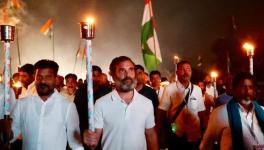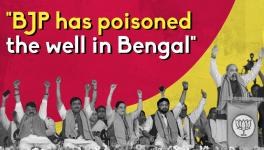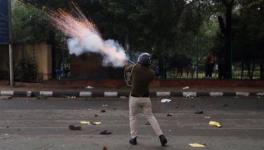CAB: A Serious Threat to Every Idea of South Asia
Let us not beat about the bush. The essence of the Citizenship Amendment Bill (CAB) can be collapsed into just one sentence: It is meant to reduce India’s Muslims to second-class citizens; proof of their Indianness endlessly demanded, but never fully accepted. The subtext is to give Hindus the sadistic satisfaction of making Muslims know their “real place” in Indian society.
But for this explanation, it is difficult to find any other rationale behind the bill, particularly at this juncture, when pressing economic issues demand immediate attention. To take this purpose to its logical end, the Bharatiya Janata Party (BJP) has also proposed a nation-wide compilation of a National Register of Citizens (NRC). In communally-charged South Asia, with a recent past of religion-centric conflicts that have consumed millions of lives, the move portends dangerous possibilities for India’s neighbourhood.
CAB prescribes that any Hindu, Buddhist, Christian, Jain, Sikh or Parsi who has been a victim of religious persecution in Islam-centric Afghanistan, Bangladesh and Pakistan and, as a result, has taken shelter as a refugee in India on or before 31 December 2014, will not be considered an illegal migrant. As the biggest Hindu-majority nation, India will offer them an easy path to naturalized Indian citizenship. The only community excluded from this benefit are the Muslims, even though they have suffered just as much religious persecution. The cases of Ahmediyas and Shias in Pakistan, and of Hazara Shias in Afghanistan easily come to mind. In Bangladesh, the most advertised case is that of the author and activist Taslima Nasrin.
CAB is a politically clever formulation for it camouflages its pro-Hindu thrust by bracketing Hindus with Buddhists, Christians, Jains, Sikhs and Parsis. For demographic reasons, the vast majority of people who crossed the borders between India and undivided Pakistan after 1947, and later between India and Bangladesh, were either Hindus or Muslims. Other communities were small in number. Among them, many indeed were Sikhs, but they were all gainfully rehabilitated in Delhi and its neighbouring states.
In recent years, a small number of Sikhs of Afghanistan have arrived in India. They have either been granted refugee status by the UNHRC in collaboration with the Indian state or have melted into the local Sikh community. The Buddhist situation is different, and in this case the BJP government has cleverly dodged the issue of Chakma and Hajong Buddhists in Arunachal Pradesh. Although the latter were granted Indian citizenship several decades ago, massive local opposition means they remain semi-citizens who have been denied the right to vote. In any case, the states of Arunachal Pradesh, Mizoram and Nagaland, and now Manipur, plus the tribal areas of Assam, are currently excluded from the purview of CAB.
Instead of wasting so much cerebral energy and precious time, the BJP could have chosen a simpler formulation: Damn India’s secularism, damn India’s commitment to international human rights covenants; Muslim migrants from Afghanistan, Bangladesh and Pakistan are illegal settlers, whose fates will hang in balance perpetually; they should not even dream of becoming Indian citizens.
Who cares to note that India has a haloed record of playing host to all kinds of oppressed communities from the region and beyond, whether they are from Afghanistan, Bhutan, Myanmar, Sri Lanka, Tibet or even Iran and other places? In the wake of the Bangladesh war in the early seventies, India had famously sheltered about 10 million refugees from East Pakistan, at least 15 per cent of whom were Muslims. All this has happened in spite of the fact India is not a signatory to the international refugee convention, to which it has expressed a principled opposition.
To put the CAB discourse in perspective, let us view it from four angles—political, economic, humanitarian, and regional. Politically, CAB gives further ‘respectability’ to communal politics in India, strengthening a trend that has been in the making for several years. We know that communalism exists in all South Asian polities, but we also recognise that it is undesirable in modern democracies. It is for this reason that every political party worth its salt publicly distances itself from communalism. Even the avowedly Hindu-chauvinistic BJP has been forced to shout from the rooftop that it believes in sabka saath, sabka vikas, sabka viswas (together, let us all develop by earning everyone’s trust). The last phrase, sabka viswas (everyone’s trust) has been added recently to address Muslims’ concerns in particular. But when it comes to playing day-to-politics, we have seen how hollow the slogan reads. My columns these past several months have dwelt extensively on this hollowness. Let me not repeat myself here.
In any case, the huge contradiction that exists in India today must not escape anybody’s attention. On the one hand, there is a clear policy thrust to see the Union of India as one single political unit at the cost of states’ rights; on the other, everything is moving in the direction of fragmenting India as a nation. One-nation-one-election, one-nation-one-tax, one-nation-one-ration card, and direct-benefit bank transfers from the central government to needy Indians over the heads of state governments (so as to establish direct communication between the Modi government and the people), tell one story.
But this story is turned on its head when state domicile becomes the major criterion to reserve 60 to 80% of government jobs for locals. Thus, the Indian state celebrates the abrogation of Article 370 that had granted Jammu and Kashmir special rights. In the same breath, and with great aplomb, that same Indian state also celebrates its commitment to protect the special rights of the north-eastern states. How could such diametrically opposite processes be simultaneously celebrated? Only lunatics or Muslim-baiters can appreciate this jugglery. After all, Jammu and Kashmir were India’s only Muslim-majority state (now split into two Union Territories).
As a schoolboy in the fifties, I was told that Inner Line Permits (ILP) to certain regions in India’s northeast were a temporary necessity and would be done away with in due course, once these regions had been fully integrated into the Indian Union. Six decades later, not only do these permits continue, they are being reinforced. Beyond the three original states of Arunachal Pradesh, Mizoram and Nagaland, additional demands for ILP are now being recognized from Assam, Meghalaya, Manipur (already granted) and Tripura. Assam’s Deputy Chief Minister and BJP’s most visible face in the region, Himanta Biswa Sarma, has categorically said that even those getting Indian citizenship under CAB would not be granted residency rights, nor would they be allowed to own land or run businesses in specified areas of Assam without the permission of the state government.
The Asom Gana Parishad (AGP), which is the BJP’s ally in the state, is demanding safeguards on the pattern of ILP. No wonder then that large sections of northeasterners are protesting against CAB. Even a section of BJP’s West Bengal unit feels that its recent electoral reverses are attributable to NRC/CAB blues.
In Manipur, Lancha Ningthouja, an ILP activist, recently said, “There is a serious danger of the indigenous Manipuri population being wiped out along with their culture, history and languages.... Why should we let outsiders (emphasis added) take over our land entirely?” Note that ‘outsiders’ here refers not to foreigners but to other Indians. Also note that Manipuris (read Meitei in this context, and not Kuki or Naga) are Hindus and their worry is not the “Bangladeshi” Muslim alone but also the Bihari and Bengali, who in most cases is an Indian Hindu.
There is little doubt, therefore, that CAB is entirely an exercise in communal politics. If Assam’s NRC drama could engage its people almost completely for three years, thereby paving the way for the BJP to consolidate its power in the state, it can reasonably be surmised that the CAB/NRC will engage the Indian masses for at least four years, to safeguard the BJP’s victory in the 2024 elections. In the intervening period, the BJP’s fifth column, the pliant media and the party’s social media troll army, will ensure that the pot keeps boiling.
Moving onto economics, CAB is going to cause an unimaginable drain on the country’s financial and human resources. Consider JNU professor Neerja Gopal Jayal’s extrapolation of Assam’s NRC experience. For a population of 33,000,000, the NRC cost Rs 16,000,000,000 and involved a work force of 50,000 officials. Given India’s 880,000,000 electorate, a nation-wide NRC would then cost Rs 4,260,000,000,000 (Rs 4.26 trillion).
Now add to this the huge cost in terms of money and time that millions of Indians will incur for registering themselves in the NRC. And to top it all, add the expenditures incurred to build and maintain the thousands of detention centres that will house the so-called stateless persons the NRC will identify.
If the Assam NRC alone identified 1,900,000 “non-Indians,” the national figure will likely be to the tune of 50,000,000. That means the Indian tax payer will have to bear the cost of millions of employable individuals, who have been forced out of India’s labour force and into internment camps. For the average Indian it will be a double whammy: Heads he/she loses; tails the BJP wins.
From a human rights perspective, volumes have already been written on Assam’s NRC experience. Multiply that at least thirty-fold to have a preliminary sense of the misery that is in store for millions of poverty-stricken illiterate Indians. To understand this humble reality, one need not have read Karl Marx or Mao Zedong. And yet, the Indian state continues to defend the NRC on the grounds that if one is unhappy with the outcome the doors of the courts are open.
In India, even the well-to-do dread approaching the courts for both financial reasons and because they face inordinate delays. Yet, we expect that the destitute will seek legal remedy in the face of 33,000,000 pending cases. Just like chartered accounts are minting money these days thanks to the complexities involved in GST filings, it would soon be boom time for lawyers specializing in citizenship litigation.
Yet another point, largely unacknowledged, is that the real sufferers will be poor Hindus. Having lived under the shadow of a muscle-flexing Hindu-majority India, poor Indian Muslims are ever conscious of the Damocles Sword that hangs over their heads. Unlike their Hindu counterparts, they are therefore more careful in maintaining their identity papers. I suspect this is the reason why many more Hindus found themselves struck off the NRC in Assam.
Last, and to my mind most important, the proposed CAB/NRC will do havoc with the notion of South Asian regionalism, especially if the exercise is taken to its logical end. Assuming that in due course India will end up with millions of impoverished Muslims languishing perpetually in detention camps, these millions will be fodder for fundamentalist politics. Groups in Pakistan will no doubt take advantage. But it is Bangladesh that may prove the bigger bogie.
Given Bangladesh’s restive 90% Muslim community, how long can India think that Bangladesh should remain unconcerned? Illegal Bangladeshis are like “termites” and each such “termite” will be identified and thrown out of India, so claims Home Minister Amit Shah. But thrown where? Has not India committed at the highest level that Bangladesh need not worry, for the illegal Bangladeshis are India’s internal matter? But who will tell India’s leaders that communal politics is not India’s monopoly alone? Bangladesh too has mastered the art. And lest we forget, 16 million out of its 200 million are Hindus.
One other reality my readers must be sensitized about. Nationality per se is no guarantee of one’s complete identification with the nation, just like denial of nationality does not necessarily make one an enemy of the nation. Sri Lanka Tamils and Indian Tamils are both Hindus, yet in the context of Sri Lanka’s national question, their respective positions are diametrically opposite. There was never any question about the citizenship status of Sri Lanka Tamils, yet it is they who wanted to secede from Sri Lanka. In contrast, Indian Tamils were always exposed to uncertainties about their Sri Lankan citizenship, yet they showed complete loyalty to the Sri Lankan nation, so much so that they even refused repatriation to India under the Shastri-Sirimavo Pact of 1964.
One last point. It may be fashionable to do so today, but everything in the world ought not to be viewed through the prism of religion. There are multiple ethnicities that get blended within an individual, something which social anthropologists call the “elasticity of ethnicity”. But it is the tragedy of political classes the world over that they undermine these diversities in favour of one-religion-one-nation. India began the age of decolonization with the promise of reversing this trend.
Alas, it too is no longer immune to the virus of reductive nationalism. As a result, South Asian nations that should be celebrating their diversity are successively becoming majoritarian. Who will tell them that behind the 70 years of post-Partition South Asia there stand seventy centuries of history? It is that much longer history, celebrated by Tagore in his poem Bharat Teertho, that makes the region what it is.
Here is an excerpt:
‘Keho nahi jane kaar ahobane kato manusher dhara
Durbar shrote elo kotha hote, samudre holo haara
Hethaye arjo, hetha anarjo, hethaye dravid cheen—
Shauk, hun dal pathan mogole ek dehe holo leen
Poschime aaji khuliachhe daar, setha hote sobe aaney upahaar,
Dibe aar nibe, milabe milibe, jabe naa phire—
Ei bharater mahamanaber sagarteerey.’
Its free translation in English would read as follows:
Noone knows to whose clarion call
Peoples responded and came in streams
And joined the ocean
Hither lived the Aryans, the non-Aryans,
The Dravidians, the Chinese, the Scythians
The Huns, the Pathans, the Mughals—
And merged into one body and soul,
Today, doors to the West are open
New ideas are flowing,
Incessant giving and taking,
Meeting and mingling are on
They will not return
From this supreme Ocean of Humanity
That is India [which then meant the India, Bangladesh, Pakistan and Myanmar of today].
Postscript. How many Bangladeshis know that the creation of Bangladesh deprived millions of Bengalis in the rest of South Asia and beyond one of their most critical identity markers? As a ‘probashi Bangali’ from Bhagalpur in Bihar, I recall that prior to 1971 whenever I had to go Kolkata, I would call my visits “journeys to Bangladesh,” that is, to the land of the Bengalis.
Those who suspect my statement are advised to look up on YouTube the famous Kishore Kumar-Lata Mangeshkar song, Main Bangaali chhokra … main Madraasi chore from the 1958 Bollywood movie, Ragini. Its Bengali protagonist goes on to claim, “Humra Bangladesh mein har gori ke lambe baal”, or, in my Bangladesh, every lass has long plaits.
Many things, over thousands of years, have gone into the making of South Asia. It is a civilisational space worth cherishing. I wish the Modi-Shah duo understood this.
The author is a senior fellow at the Institute of Social Sciences. The views are personal.
Get the latest reports & analysis with people's perspective on Protests, movements & deep analytical videos, discussions of the current affairs in your Telegram app. Subscribe to NewsClick's Telegram channel & get Real-Time updates on stories, as they get published on our website.
























